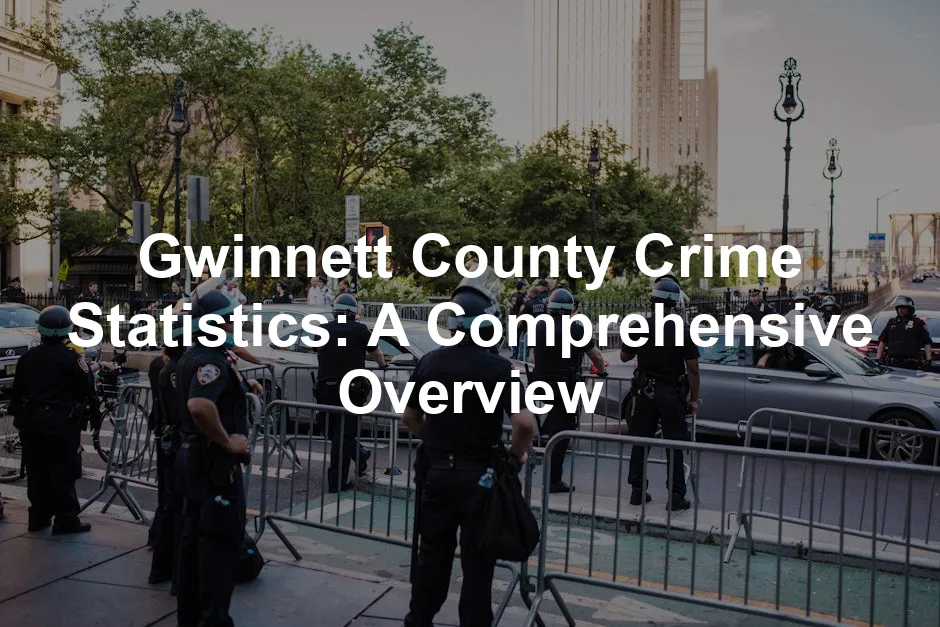Introduction
Understanding crime statistics is vital for anyone considering a move to Gwinnett County. Whether you’re a resident or a potential newcomer, knowing the safety landscape helps you make informed decisions. A quick glance at crime stats can give you insights into the safety measures in place and the effectiveness of local law enforcement.
Crime data is more than just numbers; it shapes community safety measures and law enforcement strategies. When residents are aware of crime trends, they can collaborate with law enforcement to enhance safety. This partnership fosters a sense of community and trust, crucial for maintaining a safe environment.
Sources for these statistics include the Georgia Bureau of Investigation (GBI) and the FBI’s Uniform Crime Reporting (UCR) Program. The UCR collects crime data from law enforcement agencies across the nation, ensuring that the information is both reliable and standardized. This methodology allows for a clearer understanding of the crime landscape in Gwinnett County, as well as comparisons with other regions.
While exploring the depths of crime data, you might find yourself interested in the psychological aspects of criminal behavior. To dive deeper into this intriguing subject, check out The Psychology of Criminal Conduct. This book explores the motivations behind criminal actions, providing insights that could help you understand crime trends better.
By analyzing these statistics, you can gauge the effectiveness of ongoing safety initiatives and engage in community programs designed to combat crime. Whether it’s attending neighborhood watch meetings or participating in community safety workshops, being informed is the first step toward a secure living environment.

Understanding Crime Data
What Are Crime Statistics?
Crime statistics are the backbone of law enforcement and public safety. They provide a detailed account of criminal activities in a specific area, allowing authorities to identify trends, allocate resources, and develop strategies to combat crime. Without these statistics, understanding the safety of a community would be akin to driving blindfolded—dangerous and reckless.
The data collection process primarily follows the Uniform Crime Reporting (UCR) Program. This program, established by the FBI, compiles crime reports from law enforcement agencies nationwide. It includes various categories of crime, such as violent and property crimes. The statistics help assess the severity and frequency of crime, providing critical insights for policymakers and community leaders.
Violent crimes include serious offenses such as murder, aggravated assault, and sexual assault. Property crimes involve theft, burglary, and vandalism. Understanding the distinction between these two categories is essential for grasping the full picture of community safety. While violent crimes often garner more attention due to their severe nature, property crimes can significantly impact residents’ daily lives.
For those interested in understanding more about the implications of crime, consider picking up The Complete Idiot’s Guide to Criminal Investigation. This book provides a straightforward introduction to criminal investigation techniques and principles, perfect for anyone wanting to grasp the basics.
Moreover, crime statistics are essential for identifying areas that may require additional safety measures. For instance, if property crimes spike in a particular neighborhood, law enforcement may increase patrols or launch community outreach programs. Being aware of these statistics allows residents to stay vigilant and proactive in ensuring their safety.
In conclusion, crime statistics serve as a crucial tool for law enforcement, politicians, and citizens alike. They not only inform policies and strategies but also empower individuals to contribute to their community’s safety. Understanding these numbers can lead to a more engaged, informed, and safe Gwinnett County.

How Crime Statistics are Collected in Georgia
In Georgia, crime statistics are gathered through a meticulous process. The Georgia Bureau of Investigation (GBI) oversees this effort, ensuring that accurate data reflects criminal activity across the state. The GBI operates under the framework of the FBI’s Uniform Crime Reporting (UCR) Program, which standardizes definitions and reporting procedures. This means that law enforcement agencies across Georgia follow the same guidelines when documenting crimes, making comparisons easier.
Local law enforcement agencies play a crucial role in this process. They are responsible for reporting crime data to the GBI, which then compiles and analyzes the information. Each agency submits detailed reports on serious offenses and arrests, creating a comprehensive picture of crime in their jurisdictions. This collaborative approach allows for a more robust understanding of crime trends statewide.
However, it’s essential to recognize the limitations of this data. Not all crimes are reported, leading to potential underestimations of the true crime rates. Factors such as fear of retaliation, distrust in law enforcement, or simply the belief that reporting won’t lead to action can all contribute to unreported incidents. As a result, the statistics may not fully capture the reality of crime in the community.

Overview of Gwinnett County Crime Statistics
General Crime Statistics
Gwinnett County is often deemed a relatively safe area, especially when compared to national averages. The violent crime rate stands at 19.7, notably lower than the U.S. average of 22.7. This is a pleasant surprise for residents and potential movers alike. On the flip side, the property crime rate in Gwinnett County is 49.4, which is higher than the national average of 35.4. While it’s comforting to see lower violent crime rates, the property crime figures raise an eyebrow.
Trends over the past several years show fluctuations in these rates. There has been a concerted effort from law enforcement and community organizations to address crime, leading to some positive changes. Awareness and proactive measures appear to be having an impact, but challenges remain.

Breakdown of Crimes in Gwinnett County
Let’s break down the violent crimes in Gwinnett County. These include murder, rape, robbery, and aggravated assault—serious issues that demand our attention.
- Murder: The county reported 26 murders last year. This is a sobering statistic that highlights the need for continued vigilance.
- Rape: There were 166 reported incidents of rape. This number underscores the importance of community awareness and support for victims.
- Robbery: Robberies accounted for 677 incidents. While it’s essential to remain cautious, many of these crimes are often preventable with proper community engagement.
- Aggravated Assault: The most prevalent violent crime, aggravated assaults totaled 735. This data suggests that many of these situations could benefit from intervention and education.
Each of these categories reflects the overall safety of the community. While Gwinnett County shows a relatively lower violent crime rate compared to national averages, the numbers still point to areas that require attention and community cooperation. Understanding these statistics is vital for fostering a safer environment for all residents.
The statistics paint a picture that, while encouraging in some areas, reveals critical points for improvement. Engaging with local law enforcement and community programs can help address these issues, ensuring Gwinnett County remains a desirable place to live.

Property Crimes
Property crimes are not just statistics; they impact real lives. In Gwinnett County, these crimes include burglary, larceny-theft, motor vehicle theft, and arson. Let’s break down these categories and see what the numbers reveal.
- Burglary: This involves unlawfully entering a structure with the intent to commit theft or another crime. In Gwinnett County, there were 2,793 reported burglaries last year. That’s like finding out your neighbor’s home was broken into—yikes!
- Larceny-Theft: The most common property crime, larceny-theft, involves taking someone else’s property without permission. Gwinnett County saw a whopping 10,876 incidents of larceny-theft. That’s a lot of missing lawn gnomes!
- Motor Vehicle Theft: This crime involves stealing a vehicle. Last year, Gwinnett reported 1,410 motor vehicle thefts. That’s like a bad sequel to a heist movie, but unfortunately, it’s reality for some residents.
- Arson: This crime refers to intentionally setting fire to property. Gwinnett County had 44 reported arsons last year. While it’s a smaller number, each incident could dramatically alter lives.
These numbers paint a vivid picture of property crime in Gwinnett. While the community is generally safe, being informed can help residents take proactive measures to protect their belongings. For those wanting to boost their home security, consider investing in a Ring Video Doorbell. This smart device not only allows you to see who’s at your door but also provides peace of mind when you’re away from home.

Crime Comparison with Nearby Areas
When you compare Gwinnett County to nearby cities, it’s essential to put things into perspective. Here’s a breakdown of how Gwinnett stacks up against Lawrenceville, Duluth, and Snellville:
| City | Violent Crime Rate (per 100k) | Property Crime Rate (per 100k) |
|---|---|---|
| Gwinnett County | 19.7 | 49.4 |
| Lawrenceville | 234.1 | 3,036.9 |
| Duluth | 66.9 | 1,797.1 |
| Snellville | 273.5 | 3,187.0 |
From this table, it’s clear that while property crime is a concern in Gwinnett, the violent crime rates in nearby areas like Lawrenceville and Snellville are significantly higher. These comparisons help residents and potential movers assess their safety options within the region.
Understanding these statistics is key to fostering a safer community. Being informed empowers residents to take action, whether it’s joining a neighborhood watch or simply locking their doors. After all, knowledge is power, and in this case, it can lead to a more secure Gwinnett County.

Community Safety Initiatives
Gwinnett County boasts several proactive programs aimed at boosting community safety. Local law enforcement collaborates with community organizations to implement initiatives designed to prevent crime and promote public awareness. One standout program is the Neighborhood Watch, which encourages residents to look out for one another. Meetings often involve discussions on crime trends and safety tips, making it a perfect blend of community spirit and vigilance.
Another initiative, Community Policing, allows officers to engage directly with residents. This approach fosters trust and communication, ensuring officers are familiar faces in their assigned neighborhoods. They often hold workshops that cover various topics, like home security and personal safety. Residents appreciate having a direct line to law enforcement, which can lead to faster responses to any concerns.
Community members play a vital role in these initiatives. Many participate in crime prevention efforts by volunteering for local safety programs. These volunteers often assist with educational events, helping to spread awareness and provide resources to fellow residents. By working together, the community can create a supportive network that effectively tackles crime.
In addition, Gwinnett County’s Police Department’s Crime Prevention Unit emphasizes the importance of crime statistics in shaping community safety measures. They analyze local data to identify patterns and hotspots, allowing for targeted interventions. This data-driven approach helps allocate resources efficiently, ensuring that law enforcement can respond effectively to emerging trends.
Overall, these initiatives demonstrate that a united front between law enforcement and the community can significantly enhance safety. By staying engaged, residents can effectively contribute to crime prevention efforts, creating a safer Gwinnett County for everyone. And speaking of safety, don’t forget to equip your home with a Home Security Camera System. It’s a fantastic way to keep an eye on things when you’re not around.

FAQs
What is the overall crime rate in Gwinnett County compared to Georgia?
Gwinnett County has a relatively low crime rate compared to Georgia overall. With a violent crime rate of 19.7 per 100,000 residents, it’s lower than the state average, which often reflects higher numbers. However, property crime remains a concern.
How do Gwinnett County’s crime rates compare to national averages?
Gwinnett’s violent crime rate is lower than the national average of 22.7, making it a safer option. However, property crime is higher, with a rate of 49.4 compared to the national average of 35.4.
Is Gwinnett County safe to live in?
Overall, Gwinnett County is considered safe, particularly regarding violent crime. However, residents should remain vigilant about property crime and engage with community safety initiatives to enhance their security.
What types of crimes are most prevalent in Gwinnett County?
Property crimes such as larceny-theft and burglary are the most common. Violent crimes, while lower than the national average, include aggravated assault, robbery, and sexual offenses.
What measures can residents take to enhance their safety?
Residents can enhance their safety by participating in neighborhood watch programs, attending community safety meetings, and staying informed about local crime trends. Simple actions like securing homes and reporting suspicious activities can make a big difference.
Additional Resources
Staying informed and safe in Gwinnett County is crucial. Here are some essential resources to help you dive deeper into crime statistics, community safety programs, and reporting tools.
- Gwinnett County Police Department: The official site offers a wealth of resources, including crime statistics, safety tips, and news updates. It’s a great place to start when looking for reliable information.
- Georgia Bureau of Investigation (GBI) Crime Statistics: This site provides access to the Uniform Crime Reporting (UCR) Program. You can find annual reports and data on various crime types across Georgia, including Gwinnett County.
- FBI Crime Data Explorer: Explore national crime data and specific statistics for Georgia. This tool allows you to compare crime rates across different regions, offering a broader context.
- Community Safety Programs: Gwinnett County offers various community programs aimed at enhancing safety. Look out for local initiatives like neighborhood watch programs and community policing efforts. Engaging with these initiatives can foster a sense of security and community spirit.
- Crime Reporting Tools: If you witness suspicious activities or incidents, reporting tools are available through the Gwinnett County Police website. Your vigilance can help keep the community safe.
By leveraging these resources, residents can stay updated on crime statistics and community safety measures while playing an active role in making Gwinnett County a safer place to live. Remember, knowledge is power!

For a deeper understanding of crime data, check out this article on Fremont Crime Statistics.
If you’re interested in the societal impacts of crime, I highly recommend The New Jim Crow: Mass Incarceration in the Age of Colorblindness. It’s a powerful read that discusses systemic issues within the justice system and their implications.
Please let us know what you think about our content by leaving a comment down below!
Thank you for reading till here 🙂
All images from Pexels




